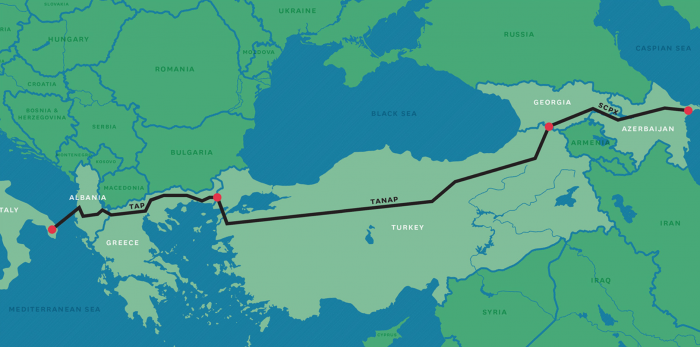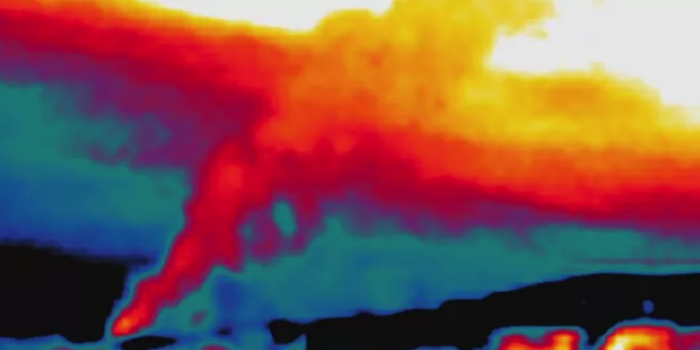In less than two weeks a section of the Southern Gas Corridor could receive the European Investment Bank’s largest ever public loan of 1.5 billion Euros but fresh analysis reveals that this pipeline will likely be dirtier than coal due to all the methane leakage associated with gas power. New research commissioned by Bankwatch shows exactly why European institutions and financiers must subject massive new energy and infrastructure projects to a climate test ensuring they will be compatible with Europe’s climate targets.
What is the Southern Gas Corridor?
The Southern Gas Corridor is a proposed interconnected system of gas pipelines stretching nearly 3,500 kilometers through six countries transporting up to 31 billion cubic meters of fossil gas from Azerbaijan to Italy (see route below).

Route and sections of the Southern Gas Corridor. Source: Bankwatch
It is a hugely expensive project estimated to cost around 45 billion US dollars, and requires the support of European public finance institutions, such as the European Investment Bank and the European Bank of Reconstruction and Development. The European Commision has admitted its failure to assess the impact of this massive new gas pipeline on the climate. That is, to determine whether or not this project adheres to Europe’s long term commitment to limit global warming to 1.5°C degrees (above pre-industrial levels) under the Paris Agreement.
This pipeline failed its climate test
European institutions and politicians may have jumped the gun and financed a pipeline without understanding the full consequences of their actions, but researchers from the Observatori del Deute en la Globalització and the Polytechnic University of Catalonia have delivered a climate test for the Southern Gas Corridor. The results are in and it is bad news: the pipeline failed because it’s climate footprint will likely be comparable to coal power. This is because of greenhouse gas emissions that always leak from the highly pressurised lines and equipment used in transporting natural gas.

Infrared image of methane leakage. Source: EDF
This new study quantifies the greenhouse gas leakage produced along the Southern Gas Corridor, focusing on extraction and transmission operations, it takes account of carbon dioxide and methane, a greenhouse gas 25 times as potent as carbon dioxide over a hundred year period. We now know:
- In 6 out of 9 projected scenarios the Southern Gas Corridor will be as damaging as coal power, in terms of emissions intensity.
- The pipeline will very likely unleash annual greenhouse gas emissions equivalent to the country of Bulgaria.
European gas expansion is a reckless undertaking
This research completely undermines claims that the Southern Gas Corridor will help to displace coal power with so-called cleaner gas – it will not help the EU meet its long-term climate targets. Instead it reinforces the argument that European gas expansion is a white elephant when it comes to finance and energy security, and downright dangerous in relation to climate change and community wellbeing.

Gas compressor and pumping station. In Europe demand is falling. Source: Siemens
There are plenty of signals to suggest that by betting on gas, European politicians and financiers are making a big mistake. In 2017 the gas industry giants Siemens and General Electric had to close their gas turbine construction facilities and lay off workers because orders have dropped off a cliff – as a result more than 12,000 people lost their jobs. Around the same time financial behemoths like the Norwegian Sovereign Wealth Fund and the World Bank announced their intentions to stop investing in gas and other fossil fuels.
Time to reassess Europe’s priority projects
Some Members of the European Parliament are starting to catch on to the dangers of the EU railroading through a swathe of massive new gas projects without adequate impact and risk assessment. Last week 13 MEPs wrote a letter of concern to the secretariat of the Parliament’s Industry Committee, formally raising an objection to the proposed ‘Projects of Common Interest’ or PCI list. These are the major infrastructure projects that are being prioritised and fast-tracked by the European Union, but the list includes plans for gas expansion that we now know could be as damaging to the climate as building new coal plants.
“It is the first post-Paris list of key energy infrastructure that Europe is supposed to have to face the energy challenges of the future, nonetheless it continues to include an extravagant number of gas projects”
Antoine Simone, Friends of the Earth
One lesson we can learn from this groundbreaking new analysis of the Southern Gas Corridor is that major new infrastructure projects on Europe’s PCI list must be subject to a climate test in order to be approved and to receive finance. There is no time to lose, climate impacts are already hitting frontline communities here and now: last year alone Europe suffered a deadly heatwave (the most severe since 2003), devastating wildfires in Portugal that killed more than 60 people, and the strongest Atlantic storm ever to hit Ireland, according to records, that took even more lives.

Wildfires on the horizon in Portugal. Source: Contando Estrelas
The divestment movement has already been extremely influential in getting financiers to take climate change into consideration and ditch fossil fuels but we need to build our strength further as Europe teeters on the edge of a climate cliff by gearing up to build massive new gas infrastructure that will lock us in to 40 more years of dangerous, dirty energy. We need to pile on the pressure to ensure that decision-makers and financiers are applying a climate test to these projects, and when they fail we must be there to cut the financial flows that breathe life into unwanted fossil fuels.
To find out how to stop gas expansion in Europe visit defundtap.org